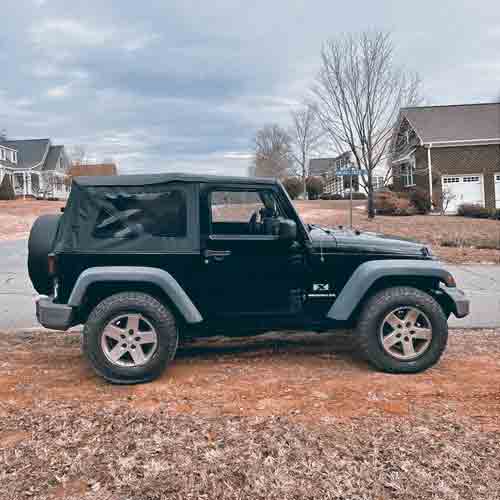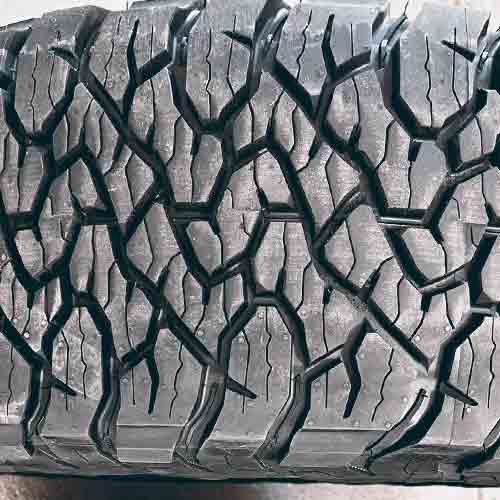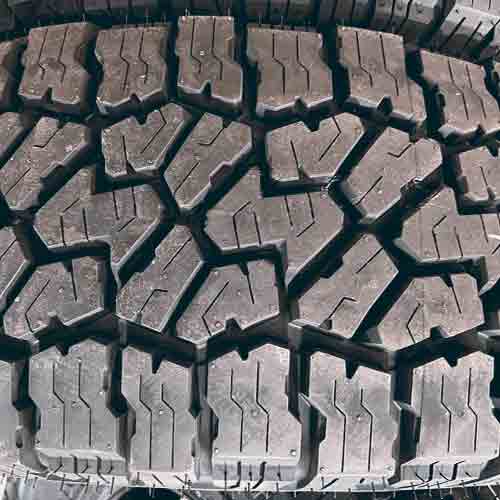The newly launched BF Goodrich KO3 and Falken Wildpeak AT4W both promise improved performance and versatility. But how well they actually are, and perform next to each other?

As a tire engineer, my tests reveal that the BF Goodrich KO3 excels in dry conditions, offering superior grip and handling, along with excellent fuel economy and traction in powdery snow. Conversely, the Falken Wildpeak AT4w takes the lead in wet conditions, delivering improved traction and grip. Furthermore, it provides better traction on packed and slick snowy surfaces, as well as better tread longevity.
Table of Contents
Sizes and their Specs
The Falken Wildpeak AT4w comes in 15 to 22 inches wheels, with following specs.
- Speed ratings: T, R, and S only.
- Load Range: SL, XL, C to F.
- Tread depth: 13 to 19.7/32″.
- Weight Range: 35.1 to 80 lbs.
- UTQG: 660 A B (on most, and 660 B B on a few sizes).
- Warranty: 60k for LT, and 65k for P metric sizes.
- All sizes have 3PMSF ratings only with M+S.
On the other hand, the BFG KO3 T/A comes in 15 to 22 inches rims, with following specs.
- Speed ratings: S and T only.
- Load range: XL and LT (only C and E available, currently).
- Tread depth: 15/32″ on all.
- Weight range: 38 lbs to 72 lbs
- Winter rating: Both 3pmsf and M+S is available.
- Treadwear warranty: 50k miles.
Tread Features
The BF Goodrich KO3 has been redesigned with a sleeker, more efficient profile.

This tire features a reduced void ratio, contributing to a more streamlined pattern.
While the central lugs no longer have the interlocking design of the KO2, they do offer improved aqua channels for enhanced water evacuation and reduced hydroplaning risk.
These lugs are more angular and include chamfered edges for added traction.
Plus, they also present an advanced design with interlocking, full-depth siping and multi-directional notches, enhancing grip and stability.
The shoulder lugs mirror this approach too, featuring sharp, chamfered biters and interlocking siping.
However, unlike its predecessor, the KO3 does not include triangular stone ejectors between the lateral grooves.
Moving towards the Falken tire.

The Wildpeak AT4W also comes with a symmetrical tread design like the KO3.
And it also features staggered shoulder blocks too, with scalloped edges, and just as aggressive of the sidewall lugs when you look at these tires side by side.
But everything else is different (design wise). Though overall structure is still not very different than the older AT3w.
I mean, you get the same Z and C shaped blocks in the middle, like the AT3w, but with a little more biting edges, and sipes better optimized for dry braking.
Though with missing interlocking sipes on the shoulders, it interestingly doesn’t outperform the older variant in terms of wet traction. You can compare both WildPeak AT3w and AT4W here.
And yes, the tire still doesn’t come with any kind of stone ejectors.
Wet Performance
In wet road conditions, two critical factors play a significant role in overall tire performance:
- Resistance to Hydroplaning: Which is primarily determined by main grooves (tread voids).
- Grip: Which is achieved through sipes (predominately).
Now grooves take out most of the water. And any remaining water is effectively managed by the sipes, which are small slits designed to suck up and disperse moisture, drying out the road further.
Having said that, it makes sense why the Wildpeak AT4W takes the lead in overall wet performance, thanks to its enhanced siping and better groove structure.
It features better interconnection of its grooves and greater tread depth going up to 19.7/32″, and both of these allow it to expel more water from the road surface right from the start.
Meaning there’s less for sipes to deal with.
Speaking of which, its sipes are pretty effective on their own as well.
While it may not offer as much wet grip as the older AT3w due to the absence of the dual-pattern siping it used to provide, it still outperforms the KO3 with its superior structure.
Furthermore, the Wildpeak AT4W features a greater number of biters in the form of in-block notches on its shoulders and Z and C-shaped central blocks, allowing it to grip the road surface more effectively while simultaneously clearing away water, resulting in better overall wet performance.
On the other hand the BF Goodrich KO3 lacks, particularly due to its lower density of silica in its composition, which makes its rubber more rigid.
This stiffer construction basically hinders the sipes’ water soaking abilities, by keeping them from flexing too much and sucking up moisture.
And although its interlocking tread pattern does pretty well in terms of hydroplaning (resistance), its lower tread depth still can’t offer as much performance as the Falken tire.
Dry Performance
When it comes to all-terrain tires, their performance on dry surfaces depends mainly on two things: how well they grip in a straight line and how they handle corners. Let’s take a closer look at these.
Directional Grip and Stability
Directional grip is all about how good a tire is at braking. And it mostly comes down to the tire’s contact patch (or footprint) in the middle.
On the other side, stability depends on the flexibility of the tread, meaning how quickly it returns to its normal shape after turning and being compressed against the road (or how quickly it straightens post-cornering).
Now out of both tires here, the BF Goodrich KO3 is taking the lead in both these key areas, thanks to its relatively more closed up central lugs, enhancing its traction.
Plus since the tire has comparatively lighter build, it keeps its momentum lower, meaning it doesn’t need as much effort to stop.
On the other hand, the Falken Wildpeak AT4w isn’t necessarily bad, but its definitely lacking here a little bit (we’re talking less than half a feet though, in my averaged 60 to 0 mph tests).
This reduced braking performance is due to the tire’s more aggressive tread pattern and heavier structure, for the most part.
Overall Handling
The effectiveness of a tire’s handling is primarily influenced by its lateral grip and stability during cornering.
And here, the tire’s shoulder area is particularly crucial, as it endures the most concentrated weight on it, as the tire turns.
Having said that, it can be seen why both tires with compact shoulder blocks and ample biters turn out with similar cornering grip, showcasing pretty much similar lateral g forces. Though still the overall handling still is better on BF Goodrich tire, where the tire showcases a whole second faster handling lap times on comparative tests (averaged).
This superiority of KO3 comes form its quicker steering feedback performance. I mean, the tire is simply more stable and it doesn’t give out as much of the floating sensation (particularly at high speeds), as the Wildpeak.
This is due to its stiffer and lighter construction/rubber, keeping lugs from bending too much as the shoulders gets compressed with the road during mid-cornering.
And with lugs not bending as much, they waste less “time“ in return back to their original form, not “delaying“ the response when the driver’s input is given to the wheels.
Winter Performance
When evaluating winter performance, there are some high expectations for these two tires, especially considering the performance of their predecessors, all of which have maintained a 3-peak mountain snowflake rating.
Though let me tell you that both tires don’t show a lot of significant improvements in comparison.
Yet, examining both tires here, the BF Goodrich KO3 outperforms in soft snowy terrains, while the WildPeak AT4W excels slightly on packed snow and relatively slippier surfaces.
So what’s going on here?
Well, the KO3 provides better snow-to-snow contact, which is important, because snow particles stick better to themselves instead of rubber.
So the tire’s hook-shaped interlocking lug design picks up and captures snow particles better providing a more effective snow traction.
On the other side, the Wildpeak AT4w stands out (on slicker surfaces), with its superior siping design and more sophisticated biters, providing the micro-level biting action needed for superior traction on slippery snowy surfaces.
Traction Off Road
Off-road terrains vary in difficulty, with challenges ranging from muddy conditions to gravel and dirt-filled roads, some of which are more suitable for on-road-oriented tires. Let’s explore these different terrains in detail.
Mud Traction
When it comes to driving on muddy surfaces, tightly packed tread blocks are not effective. This explains why both tires, featuring closed shoulder lugs, struggle to gain traction in mud, especially when attempting sideways movement.
Though still overall, the Falken Wildpeak AT4w comes out a little better, with its slightly more open groove structure and deeper tread depth, enhancing its self-cleaning capabilities and, consequently, its performance in muddy conditions.
On the other hand, the BF Goodrich KO3 lacks here, as it incorporates hook-shaped lugs in the center, which tend to hold onto mud.
However, the tire does compensates for this by offering improved scooping abilities through its serrated edges and sidewall lugs.
On Sand
When navigating sandy terrain, it’s almost a rule to lower the tire’s air pressure to achieve that needed “floating” effect.
And factors such as tire weight and tread structure play a role in this process.
Having said that, it makes sense why the Wildpeak AT4w excels here by offering a superior contact patch.
While both tires feature scalloped shoulder lugs and robust sidewall lugs, the Falken’s lugs spread out more effectively when the air pressure is lowered, resulting in increased rubber-to-sand contact.
The KO3 on the flip side although performs reasonably well in this regard too, but it still falls slightly short here due to its relatively stiffer sidewalls, which are more prone to digging in.
On Rocks
Handling rocky terrains requires a tire to provide grip in both horizontal and vertical directions, especially when climbing is involved to prevent vehicle overturning due to inadequate traction.
In this scenario, both tires deliver good enough performance, making it challenging to favor one over the other.
I mean, both boys offer substantial traction, with Falken providing notches in various directions and KO3 featuring interlocking lugs, ensuring grip from all angles.
Furthermore, they both come out with robust sidewall construction, featuring three-ply sidewalls for durability and thick lugs on sidewalls that flex effectively when air pressure is lowered, ensuring the necessary traction on all kinds of rocky surfaces.
Tread Wear and Fuel Economy
Tire longevity and fuel efficiency are influenced by various factors, including the tire’s weight, tread composition, and tread depth. And in a comprehensive evaluation, both tires here exhibit very similar overall performance.
However, if we dive into the details, the BFG KO3 comes out slightly better in terms of fuel economy, while the Falken AT4w excels in terms of tread longevity.
The BF Goodrich tire stands out due to its comparatively lighter construction across various sizes. And this, coupled with an more optimized contact patch that evenly distributes its weight, results in reduced rolling resistance and, consequently, improved fuel efficiency.
On the contrary, the Wildpeak AT4w is heavier, which causes greater road-contact friction as its rubber rubs against the ground. However, the tire still provides superior longevity.
And this is due to its robust outer layer and, notably, its greater tread depth, which takes longer to wear down to the legal tread depth limit of 2/32 inches in the United States.
Wrapping Up
So overall, both tires here have their particular strengths and weaknesses.
In dry conditions, the BF Goodrich performs better with superior grip and handling, while the Falken tire lags slightly due to its aggressive tread and weight.
Though in wet condition, opposite happens, and here Wildpeak takes the lead.
In winter performance, both tires do great offering 3PMSF ratings (along with M+S). Though diving deep, KO3 shows better snow performance, while Falken takes the lead on ice like terrains (which are packed up, and slicker).
Other than this, both tires offer pretty decent off-road performance, with Falken AT4W excelling in most. Plus this tire also take the lead in terms of tread longevity, though lacks to its counterpart in terms of fuel economy.
Hey Ozmen,
In your opinion, what is the best tire in this segment if you’re towing 11K trailers, driving in the snow, and occasionally going down Jeep roads?
Thanks!
Well snow performance is better on KO3 actually. But if you put in towing, I guess you should go for Wildpeak AT4w. Though make sure to check out my main A/T tires page first (its on the homepage).
I’d choose Toyo Open Country at3 in LT rating personally for that. They’re 3 peak rated, lighter than a lot of other LT rated tires, and have a good warranty. But I use Falken Wildepeak AT3W XL load on my midsized truck for everything else.
All things being equal road noise is a major factor for me. And in this the Falken AT3w excels. It’s very quiet and very smooth on the highway in my opinion.
Thanks for sharing, I am currently testing out the comfort performance of both tires, would update once I finalized.